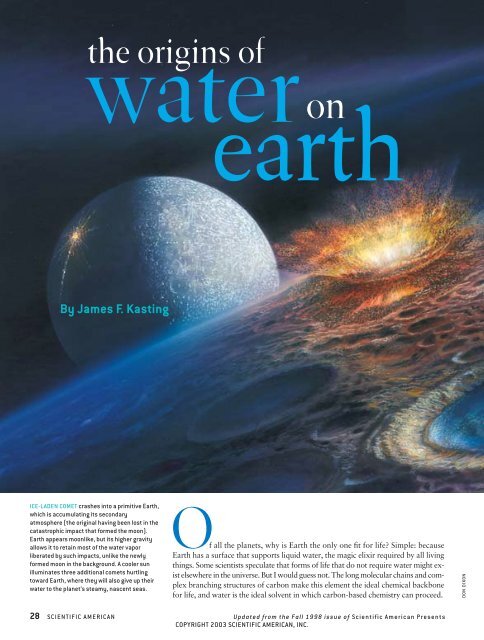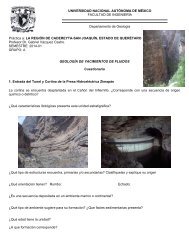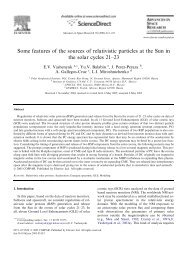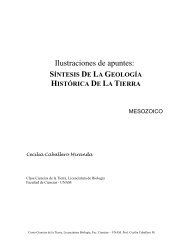New Light on the Solar System
New Light on the Solar System
New Light on the Solar System
Create successful ePaper yourself
Turn your PDF publications into a flip-book with our unique Google optimized e-Paper software.
water<br />
<strong>the</strong> origins of<br />
earth<br />
<strong>on</strong><br />
By James F. Kasting<br />
ICE-LADEN COMET crashes into a primitive Earth,<br />
which is accumulating its sec<strong>on</strong>dary<br />
atmosphere (<strong>the</strong> original having been lost in <strong>the</strong><br />
catastrophic impact that formed <strong>the</strong> mo<strong>on</strong>).<br />
Earth appears mo<strong>on</strong>like, but its higher gravity<br />
allows it to retain most of <strong>the</strong> water vapor<br />
liberated by such impacts, unlike <strong>the</strong> newly<br />
formed mo<strong>on</strong> in <strong>the</strong> background. A cooler sun<br />
illuminates three additi<strong>on</strong>al comets hurtling<br />
toward Earth, where <strong>the</strong>y will also give up <strong>the</strong>ir<br />
water to <strong>the</strong> planet’s steamy, nascent seas.<br />
Of all <strong>the</strong> planets, why is Earth <strong>the</strong> <strong>on</strong>ly <strong>on</strong>e fit for life? Simple: because<br />
Earth has a surface that supports liquid water, <strong>the</strong> magic elixir required by all living<br />
things. Some scientists speculate that forms of life that do not require water might exist<br />
elsewhere in <strong>the</strong> universe. But I would guess not. The l<strong>on</strong>g molecular chains and complex<br />
branching structures of carb<strong>on</strong> make this element <strong>the</strong> ideal chemical backb<strong>on</strong>e<br />
for life, and water is <strong>the</strong> ideal solvent in which carb<strong>on</strong>-based chemistry can proceed.<br />
DON DIXON<br />
28 SCIENTIFIC AMERICAN Updated from <strong>the</strong> Fall 1998 issue of Scientific American Presents<br />
COPYRIGHT 2003 SCIENTIFIC AMERICAN, INC.
Evidence is mounting that o<strong>the</strong>r planets<br />
hosted oceans at <strong>on</strong>e time, but ONLY EARTH has<br />
maintained its watery endowment<br />
Given this special c<strong>on</strong>necti<strong>on</strong> between water and life, many<br />
investigators have lately focused <strong>the</strong>ir attenti<strong>on</strong> <strong>on</strong> <strong>on</strong>e of Jupiter’s<br />
mo<strong>on</strong>s, Europa. Astr<strong>on</strong>omers believe this small world<br />
may possess an ocean of liquid water underneath its globeencircling<br />
crust of ice. NASA researchers are making plans to<br />
measure <strong>the</strong> thickness of ice <strong>on</strong> Europa using radar and, eventually,<br />
to drill through that layer should it prove thin enough.<br />
The envir<strong>on</strong>ment of Europa differs dramatically from c<strong>on</strong>diti<strong>on</strong>s<br />
<strong>on</strong> Earth, so <strong>the</strong>re is no reas<strong>on</strong> to suppose that life must<br />
have evolved <strong>the</strong>re. But <strong>the</strong> very existence of water <strong>on</strong> Europa<br />
provides sufficient motivati<strong>on</strong> for sending a spacecraft to<br />
search for extraterrestrial organisms. Even if that probing finds<br />
nothing alive, <strong>the</strong> effort may help answer a questi<strong>on</strong> closer to<br />
home: Where did water <strong>on</strong> Earth come from?<br />
Water from Heaven<br />
CREATION OF THE MODERN OCEANS required two obvious<br />
ingredients: water and a c<strong>on</strong>tainer in which to hold it. The<br />
ocean basins owe <strong>the</strong>ir origins, as well as <strong>the</strong>ir present c<strong>on</strong>figurati<strong>on</strong>,<br />
to plate tect<strong>on</strong>ics. This heat-driven c<strong>on</strong>vecti<strong>on</strong> churns<br />
www.sciam.com SCIENTIFIC AMERICAN 29<br />
COPYRIGHT 2003 SCIENTIFIC AMERICAN, INC.
BARRAGE OF COMETS nears an end as<br />
a late-arriving body hits at <strong>the</strong> horiz<strong>on</strong>,<br />
sending shocks through <strong>the</strong> planet and<br />
stirring up this primordial sea.<br />
<strong>the</strong> mantle of Earth—<strong>the</strong> regi<strong>on</strong> between<br />
<strong>the</strong> crust and core—and results in <strong>the</strong> separati<strong>on</strong><br />
of two kinds of material near <strong>the</strong><br />
surface. <str<strong>on</strong>g>Light</str<strong>on</strong>g>er, less dense granitic rock<br />
makes up <strong>the</strong> c<strong>on</strong>tinents, which float like<br />
sp<strong>on</strong>ges in <strong>the</strong> bath over denser, heavier<br />
basalt, which forms <strong>the</strong> ocean basins.<br />
Scientists cannot determine with certainty<br />
exactly when <strong>the</strong>se depressi<strong>on</strong>s<br />
filled or from where <strong>the</strong> water came, because<br />
<strong>the</strong>re is no geologic record of <strong>the</strong><br />
formative years of Earth. Dating of meteorites<br />
shows that <strong>the</strong> solar system is<br />
about 4.6 billi<strong>on</strong> years old, and Earth appears<br />
to be approximately <strong>the</strong> same age.<br />
The oldest sedimentary rocks—those<br />
that formed by processes requiring liquid<br />
water—are <strong>on</strong>ly about 3.9 billi<strong>on</strong> years<br />
Depth<br />
(kilometers)<br />
0<br />
1<br />
2<br />
3<br />
4<br />
5<br />
6<br />
old. But <strong>the</strong>re are crystals of zirc<strong>on</strong>ium<br />
silicate, called zirc<strong>on</strong>s, that formed 4.4<br />
billi<strong>on</strong> years ago and whose oxygen isotopic<br />
compositi<strong>on</strong> indicates that liquid<br />
water was present <strong>the</strong>n. So water has<br />
been <strong>on</strong> Earth’s surface throughout most<br />
of its history.<br />
Kevin J. Zahnle, an astr<strong>on</strong>omer at <strong>the</strong><br />
NASA Ames Research Center, suggests<br />
that <strong>the</strong> primordial Earth was like a bucket.<br />
In his view, water was added not with<br />
a ladle but with a firehose. He proposes<br />
that icy clumps of material collided with<br />
Earth during <strong>the</strong> initial formati<strong>on</strong> of <strong>the</strong><br />
planet, injecting huge quantities of water<br />
into <strong>the</strong> atmosphere in <strong>the</strong> form of steam.<br />
Much of this water streamed skyward<br />
through holes in <strong>the</strong> atmosphere blasted<br />
ATLANTIC OCEAN BASIN<br />
0 500 1,000 1,500 2,000<br />
Distance (kilometers)<br />
TOPOGRAPHIC MAPPING of Mars has recently revealed remarkable<br />
similarities to <strong>the</strong> ocean basins <strong>on</strong> Earth. For example, <strong>the</strong> western<br />
open by <strong>the</strong>se icy planetesimals <strong>the</strong>mselves.<br />
Many of <strong>the</strong> water molecules<br />
(H 2 O) were split apart by ultraviolet radiati<strong>on</strong><br />
from <strong>the</strong> sun. But enough of <strong>the</strong><br />
initial steam in <strong>the</strong> atmosphere survived<br />
and c<strong>on</strong>densed to form sizable oceans<br />
when <strong>the</strong> planet eventually cooled.<br />
No <strong>on</strong>e knows how much water<br />
rained down <strong>on</strong> <strong>the</strong> planet at <strong>the</strong> time.<br />
But suppose <strong>the</strong> bombarding planetesimals<br />
resembled <strong>the</strong> most abundant type<br />
of meteorite (called ordinary ch<strong>on</strong>drite),<br />
which c<strong>on</strong>tains about 0.1 percent water<br />
by weight. An Earth composed entirely<br />
of this kind of rubble would <strong>the</strong>refore<br />
have started with 0.1 percent water—at<br />
least four times <strong>the</strong> amount now held in<br />
<strong>the</strong> oceans. So three quarters of this wa-<br />
NORTHERN POLAR BASIN ON MARS<br />
0 500 1,000 1,500 2,000<br />
Distance (kilometers)<br />
Atlantic near Rio de Janeiro (left) presents a similar profile to that of <strong>the</strong><br />
nor<strong>the</strong>rn polar basin <strong>on</strong> Mars (right).<br />
DON DIXON (top); DAVID SCHNEIDER (bottom)<br />
30 SCIENTIFIC AMERICAN NEW LIGHT ON THE SOLAR SYSTEM<br />
COPYRIGHT 2003 SCIENTIFIC AMERICAN, INC.
ter has since disappeared. Perhaps half an<br />
ocean of <strong>the</strong> moisture became trapped<br />
within minerals of <strong>the</strong> mantle. Water may<br />
also have taken up residence in Earth’s<br />
dense ir<strong>on</strong> core, which c<strong>on</strong>tains some relatively<br />
light elements, including, most<br />
probably, hydrogen.<br />
The initial influx of meteoric material<br />
probably endowed Earth with more<br />
than enough water for <strong>the</strong> oceans. Indeed,<br />
that bombardment lasted a l<strong>on</strong>g<br />
time: from 4.5 billi<strong>on</strong> to 3.8 billi<strong>on</strong> years<br />
ago, a time called, naturally enough, <strong>the</strong><br />
heavy bombardment period.<br />
Where <strong>the</strong>se hefty bodies came from<br />
is still a mystery. They may have originated<br />
in <strong>the</strong> asteroid belt, which is located<br />
between <strong>the</strong> orbits of Mars and Jupiter.<br />
The rocky masses in <strong>the</strong> outer parts<br />
of <strong>the</strong> belt may hold up to 20 percent water.<br />
Alternatively, if <strong>the</strong> late-arriving bodies<br />
came from bey<strong>on</strong>d <strong>the</strong> orbit of Jupiter,<br />
<strong>the</strong>y would have resembled ano<strong>the</strong>r<br />
water-bearing candidate—comets.<br />
Comets are often described as dirty<br />
cosmic snowballs: half ice, half dust.<br />
Christopher F. Chyba, a planetary scientist<br />
at <strong>the</strong> University of Ariz<strong>on</strong>a, estimates<br />
that if <strong>on</strong>ly 25 percent of <strong>the</strong> bodies<br />
that hit Earth during <strong>the</strong> heavy bombardment<br />
period were comets, <strong>the</strong>y<br />
could have accounted for all <strong>the</strong> water in<br />
<strong>the</strong> modern oceans. This <strong>the</strong>ory is attractive<br />
because it could explain <strong>the</strong> extended<br />
period of heavy bombardment:<br />
bodies originating in <strong>the</strong> Uranus-Neptune<br />
regi<strong>on</strong> would have taken l<strong>on</strong>ger to<br />
be swept up by planets, so <strong>the</strong> volley of<br />
impacts <strong>on</strong> Earth would have stretched<br />
over hundreds of milli<strong>on</strong>s of years.<br />
Alternatively, <strong>the</strong> impactors may<br />
have come from <strong>the</strong> asteroid belt regi<strong>on</strong><br />
between 2.0 astr<strong>on</strong>omical units (AU, <strong>the</strong><br />
mean distance from Earth to <strong>the</strong> sun)<br />
and 3.5 AU. Alessandro Morbidelli of<br />
<strong>the</strong> Observatory of <strong>the</strong> Côte d’Azur in<br />
France and his co-workers have shown<br />
that asteroids whose orbits were highly<br />
inclined to <strong>the</strong> plane of <strong>the</strong> solar system<br />
THE AUTHOR<br />
JAMES F. KASTING received his bachelor’s degree in chemistry and physics from Harvard<br />
University. He went <strong>on</strong> to graduate studies in physics and atmospheric science at <strong>the</strong> University<br />
of Michigan at Ann Arbor, where he obtained a doctorate in 1979. Kasting worked at<br />
<strong>the</strong> Nati<strong>on</strong>al Center for Atmospheric Research and for <strong>the</strong> NASA Ames Research Center before<br />
joining Pennsylvania State University, where he now teaches in <strong>the</strong> departments of<br />
geosciences and meteorology. Kasting’s research focuses <strong>on</strong> <strong>the</strong> evoluti<strong>on</strong> of habitable<br />
planets around <strong>the</strong> sun and o<strong>the</strong>r stars.<br />
Mars<br />
Earth<br />
could have c<strong>on</strong>tinued to pelt Earth for a<br />
similar period.<br />
This widely accepted <strong>the</strong>ory of an<br />
ancient cometary firehose has recently<br />
hit a major snag. Astr<strong>on</strong>omers have<br />
found that three comets—Halley, Hyakutake<br />
and Hale-Bopp—have a high<br />
percentage of deuterium, a form of hydrogen<br />
that c<strong>on</strong>tains a neutr<strong>on</strong> as well as<br />
a prot<strong>on</strong> in its nucleus. Compared with<br />
normal hydrogen, deuterium is twice as<br />
abundant in <strong>the</strong>se comets as it is in seawater.<br />
One can imagine that <strong>the</strong> oceans<br />
might now hold proporti<strong>on</strong>ately more<br />
deuterium than <strong>the</strong> cometary ices from<br />
which <strong>the</strong>y formed, because normal hydrogen,<br />
being lighter, might escape <strong>the</strong><br />
tug of gravity more easily and be lost to<br />
space. But it is difficult to see how <strong>the</strong><br />
oceans could c<strong>on</strong>tain proporti<strong>on</strong>ately<br />
less deuterium. If <strong>the</strong>se three comets are<br />
representative of those that struck here<br />
in <strong>the</strong> past, <strong>the</strong>n most of <strong>the</strong> water <strong>on</strong><br />
Earth must have come from elsewhere.<br />
A c<strong>on</strong>troversial idea based <strong>on</strong> observati<strong>on</strong>s<br />
from satellites suggests that<br />
about 20 small (house-size) comets<br />
bombard Earth every minute.<br />
This rate, which is fast<br />
enough to fill <strong>the</strong> entire<br />
ocean over <strong>the</strong> lifetime<br />
of Earth, implies that<br />
<strong>the</strong> ocean is still growing.<br />
This much debated<br />
<strong>the</strong>ory, champi<strong>on</strong>ed<br />
by Louis A.<br />
Frank of <strong>the</strong> University<br />
of Iowa, raises<br />
many unanswered<br />
questi<strong>on</strong>s, am<strong>on</strong>g<br />
<strong>the</strong>m: Why do <strong>the</strong> objects<br />
not show up <strong>on</strong> radar? Why do<br />
<strong>the</strong>y break up at high altitude? And <strong>the</strong><br />
deuterium paradox remains, unless<br />
<strong>the</strong>se “cometesimals” c<strong>on</strong>tain less deuterium<br />
than <strong>the</strong>ir larger cousins.<br />
More recently, Morbidelli has argued<br />
c<strong>on</strong>vincingly that most of Earth’s water<br />
came from <strong>the</strong> asteroid belt. The ordinary<br />
ch<strong>on</strong>drites are thought to come<br />
from <strong>the</strong> inner part of this regi<strong>on</strong> (2.0 to<br />
2.5 AU). But outer-belt asteroids (2.5 to<br />
3.5 AU) are thought to be water-rich. According<br />
to Morbidelli, as Earth formed it<br />
collided with <strong>on</strong>e or more large planetesimals<br />
from <strong>the</strong> outer belt. Gravitati<strong>on</strong>al<br />
perturbati<strong>on</strong>s caused by Jupiter<br />
el<strong>on</strong>gated <strong>the</strong> planetesimal’s orbit, allowing<br />
it to pass within Earth’s orbit.<br />
Earth may have picked up additi<strong>on</strong>al water<br />
from asteroids <strong>on</strong> highly inclined orbits<br />
that arrived during <strong>the</strong> heavy bombardment<br />
period. In this scheme, no<br />
more than 10 percent of Earth’s water<br />
came from comets that originated far<strong>the</strong>r<br />
Ancient habitable z<strong>on</strong>e<br />
Venus<br />
Mercury<br />
Sun<br />
EDWARD BELL<br />
HABITABLE ZONE, where liquid water can exist <strong>on</strong> <strong>the</strong> surface of a planet, now ranges<br />
from just inside <strong>the</strong> orbit of Earth to bey<strong>on</strong>d <strong>the</strong> orbit of Mars (blue). This z<strong>on</strong>e has<br />
migrated slowly outward from its positi<strong>on</strong> when <strong>the</strong> planets first formed (yellow), about<br />
4.6 billi<strong>on</strong> years ago, because <strong>the</strong> sun has gradually brightened over time. In ano<strong>the</strong>r billi<strong>on</strong><br />
years, when Earth no l<strong>on</strong>ger resides within this expanding z<strong>on</strong>e, <strong>the</strong> water in <strong>the</strong> oceans will<br />
evaporate, leaving <strong>the</strong> world as dry and lifeless as Venus is today.<br />
Habitable<br />
z<strong>on</strong>e<br />
today<br />
www.sciam.com SCIENTIFIC AMERICAN 31<br />
COPYRIGHT 2003 SCIENTIFIC AMERICAN, INC.
out in <strong>the</strong> solar system. This <strong>the</strong>ory is<br />
c<strong>on</strong>sistent with deuterium-hydrogen ratios,<br />
which indicate that <strong>the</strong> comets’ watery<br />
c<strong>on</strong>tributi<strong>on</strong>s were small.<br />
The Habitable Z<strong>on</strong>e<br />
WHATEVER THE SOURCE, plenty of<br />
water fell to Earth early in its life. But<br />
simply adding water to an evolving planet<br />
does not ensure <strong>the</strong> development of a<br />
persistent ocean. Venus was probably<br />
also wet when it formed, but its surface<br />
is completely parched today.<br />
How that drying came about is easy<br />
to understand: sunshine <strong>on</strong> Venus must<br />
have <strong>on</strong>ce been intense enough to create<br />
a warm, moist lower atmosphere and to<br />
support an appreciable amount of water<br />
in <strong>the</strong> upper atmosphere as well. As a result,<br />
water <strong>on</strong> <strong>the</strong> surface of Venus evaporated<br />
and traveled high into <strong>the</strong> sky,<br />
where ultraviolet light broke <strong>the</strong> molecules<br />
of H 2 O apart and allowed hydrogen<br />
to escape into space. Thus, this key<br />
comp<strong>on</strong>ent of water <strong>on</strong> Venus took a<br />
<strong>on</strong>e-way route: up and out.<br />
This sunshine-induced exodus implies<br />
that <strong>the</strong>re is a critical inner boundary<br />
to <strong>the</strong> habitable z<strong>on</strong>e around <strong>the</strong><br />
sun, which lies bey<strong>on</strong>d <strong>the</strong> orbit of<br />
Venus. C<strong>on</strong>versely, if a planet does not<br />
receive enough sunlight, its oceans may<br />
freeze by a process called runaway glaciati<strong>on</strong>.<br />
Suppose Earth somehow slipped<br />
slightly far<strong>the</strong>r from <strong>the</strong> sun. As <strong>the</strong> solar<br />
rays faded, <strong>the</strong> climate would get<br />
colder and <strong>the</strong> polar ice caps would expand.<br />
Because snow and ice reflect more<br />
sunlight back to space, <strong>the</strong> climate would<br />
become colder still. This vicious cycle<br />
could explain in part why Mars, which<br />
occupies <strong>the</strong> next orbit out from Earth,<br />
is frozen today.<br />
The actual story of Mars is probably<br />
more complicated. Pictures taken from<br />
<strong>the</strong> Mariner and Viking probes and from<br />
<strong>the</strong> Global Surveyor spacecraft show that<br />
older parts of <strong>the</strong> Martian surface are<br />
laced with channels carved by liquid water.<br />
Measurements from <strong>the</strong> laser altimeter<br />
<strong>on</strong> board <strong>the</strong> Global Surveyor indicate<br />
that <strong>the</strong> vast nor<strong>the</strong>rn plains of Mars<br />
are excepti<strong>on</strong>ally flat. The <strong>on</strong>ly corresp<strong>on</strong>dingly<br />
smooth surfaces <strong>on</strong> Earth lie<br />
<strong>on</strong> <strong>the</strong> seafloor, far from <strong>the</strong> midocean<br />
ridges. Thus, many scientists are now<br />
even more c<strong>on</strong>fident that Mars <strong>on</strong>ce had<br />
an ocean. Mars, it would seem, orbits<br />
within a potentially habitable z<strong>on</strong>e<br />
around <strong>the</strong> sun. But somehow, e<strong>on</strong>s ago,<br />
it plunged into its current chilly state.<br />
A Once Faint Sun<br />
UNDERSTANDING THAT dramatic<br />
change <strong>on</strong> Mars may help explain nagging<br />
questi<strong>on</strong>s about <strong>the</strong> ancient oceans<br />
of Earth. Theories of solar evoluti<strong>on</strong> predict<br />
that when <strong>the</strong> sun first became stable,<br />
it was 30 percent dimmer than it is<br />
now. The smaller solar output would<br />
have caused <strong>the</strong> oceans to be completely<br />
frozen before about two billi<strong>on</strong> years<br />
ago. But <strong>the</strong> geologic record tells a different<br />
tale: liquid water and life were<br />
both present as early as 3.8 billi<strong>on</strong> years<br />
ago. The disparity between this predicti<strong>on</strong><br />
and fossil evidence has been termed<br />
<strong>the</strong> faint young sun paradox.<br />
The paradox disappears <strong>on</strong>ly when<br />
<strong>on</strong>e recognizes that <strong>the</strong> compositi<strong>on</strong> of<br />
<strong>the</strong> atmosphere has changed c<strong>on</strong>siderably<br />
over time. The early atmosphere<br />
probably c<strong>on</strong>tained much more carb<strong>on</strong><br />
dioxide than at present and perhaps<br />
more methane. Both <strong>the</strong>se gases enhance<br />
<strong>the</strong> greenhouse effect because <strong>the</strong>y absorb<br />
infrared radiati<strong>on</strong>; <strong>the</strong>ir presence<br />
could have kept <strong>the</strong> early Earth warm,<br />
despite less heat coming from <strong>the</strong> sun.<br />
The greenhouse phenomen<strong>on</strong> also<br />
helps to keep Earth’s climate in a dynamic<br />
equilibrium through a process<br />
called <strong>the</strong> carb<strong>on</strong>ate-silicate cycle. Volcanoes<br />
c<strong>on</strong>tinually belch carb<strong>on</strong> dioxide<br />
into <strong>the</strong> atmosphere. But silicate minerals<br />
<strong>on</strong> <strong>the</strong> c<strong>on</strong>tinents absorb much of<br />
this gas as <strong>the</strong>y erode from crustal rocks<br />
and wash out to sea. The carb<strong>on</strong> dioxide<br />
<strong>the</strong>n sinks to <strong>the</strong> bottom of <strong>the</strong> ocean<br />
in <strong>the</strong> form of solid calcium carb<strong>on</strong>ate.<br />
Over milli<strong>on</strong>s of years, plate tect<strong>on</strong>ics<br />
drives this carb<strong>on</strong>ate down into <strong>the</strong> up-<br />
ICY BLOCKS cover <strong>the</strong> surface of <strong>the</strong> Weddell Sea off Antarctica (left);<br />
similarly shaped blocks blanket <strong>the</strong> surface of Europa, a mo<strong>on</strong> of Jupiter<br />
(right). This resemblance, and <strong>the</strong> lack of craters <strong>on</strong> Europa, suggests that<br />
liquid water exists below <strong>the</strong> frozen surface of that body.<br />
GALEN ROWELL Mountain <str<strong>on</strong>g>Light</str<strong>on</strong>g> ( left); NASA/JET PROPULSION LABORATORY (right)<br />
32 SCIENTIFIC AMERICAN NEW LIGHT ON THE SOLAR SYSTEM<br />
COPYRIGHT 2003 SCIENTIFIC AMERICAN, INC.
c<br />
a<br />
GLOBAL OCEAN<br />
b<br />
CONTINENTAL ROCKS<br />
MARINE SEDIMENTS<br />
TOM MOORE (illustrati<strong>on</strong>); ANDREW SYRED SPL/Photo Researchers, Inc. ( inset)<br />
per mantle, where it reacts chemically<br />
and is spewed out as carb<strong>on</strong> dioxide<br />
again through volcanoes.<br />
If Earth had ever suffered a global<br />
glaciati<strong>on</strong>, silicate rocks, for <strong>the</strong> most<br />
part, would have stopped eroding. But<br />
volcanic carb<strong>on</strong> dioxide would have c<strong>on</strong>tinued<br />
to accumulate in <strong>the</strong> atmosphere<br />
until <strong>the</strong> greenhouse effect became large<br />
enough to melt <strong>the</strong> ice. And eventually<br />
<strong>the</strong> warmed oceans would have released<br />
enough moisture to bring <strong>on</strong> heavy rains<br />
and to speed erosi<strong>on</strong>, in <strong>the</strong> process<br />
pulling carb<strong>on</strong> dioxide out of <strong>the</strong> atmosphere<br />
and out of minerals. Thus, Earth<br />
has a built-in <strong>the</strong>rmostat that automatically<br />
maintains its surface temperature<br />
within <strong>the</strong> range of liquid water.<br />
Paul Hoffman and Daniel Schrag of<br />
Harvard University have argued that<br />
Earth did freeze over at least twice during<br />
<strong>the</strong> Late Precambrian era, 600 to 750<br />
milli<strong>on</strong> years ago. Earth recovered with<br />
a buildup of volcanic carb<strong>on</strong> dioxide.<br />
This <strong>the</strong>ory remains c<strong>on</strong>troversial because<br />
scientists do not fully understand<br />
how <strong>the</strong> biota would have survived, but<br />
I am c<strong>on</strong>vinced it happened. There is no<br />
A GEOCHEMICAL THERMOSTAT,<br />
<strong>the</strong> carb<strong>on</strong>ate-silicate cycle, holds Earth’s<br />
surface temperature in <strong>the</strong> range of water. Atmospheric<br />
carb<strong>on</strong> dioxide dissolves in rain and reacts with eroding rocks,<br />
liberating calcium and bicarb<strong>on</strong>ate i<strong>on</strong>s into streams (a). Carried into <strong>the</strong><br />
oceans, <strong>the</strong>se i<strong>on</strong>s are used by marine organisms, such as foraminifera (inset), to<br />
c<strong>on</strong>struct shells or exoskelet<strong>on</strong>s of calcium carb<strong>on</strong>ate, which are deposited <strong>on</strong> <strong>the</strong> seafloor when<br />
<strong>the</strong> creatures die (b). Milli<strong>on</strong>s of years later <strong>the</strong> deposits slide under c<strong>on</strong>tinental crust in subducti<strong>on</strong><br />
z<strong>on</strong>es. Here high temperature and pressure cook <strong>the</strong> carb<strong>on</strong>ates to release carb<strong>on</strong> dioxide through<br />
subducti<strong>on</strong>-z<strong>on</strong>e volcanoes (c). Carb<strong>on</strong> dioxide reenters <strong>the</strong> atmosphere, and <strong>the</strong> cycle renews.<br />
o<strong>the</strong>r good way to explain <strong>the</strong> evidence<br />
for c<strong>on</strong>tinental-scale, low-latitude glaciati<strong>on</strong>.<br />
Six hundred milli<strong>on</strong> years ago, Australia<br />
straddled <strong>the</strong> equator, and it was<br />
glaciated from <strong>on</strong>e end to <strong>the</strong> o<strong>the</strong>r.<br />
The same mechanism may have operated<br />
<strong>on</strong> Mars. Although <strong>the</strong> planet is<br />
now volcanically inactive, it <strong>on</strong>ce had<br />
many erupti<strong>on</strong>s and could have maintained<br />
a vigorous carb<strong>on</strong>ate-silicate cycle.<br />
If Mars has sufficient stores of carb<strong>on</strong>—<strong>on</strong>e<br />
questi<strong>on</strong> that NASA scientists<br />
hope to answer with <strong>the</strong> Global Surveyor—it<br />
could also have had a dense<br />
shroud of carb<strong>on</strong> dioxide at <strong>on</strong>e time.<br />
Clouds of carb<strong>on</strong> dioxide ice, which<br />
scatter infrared radiati<strong>on</strong>, and perhaps a<br />
small amount of methane would have<br />
generated enough greenhouse heating to<br />
maintain liquid water <strong>on</strong> <strong>the</strong> surface.<br />
Mars is freeze-dried today not because<br />
it is too far from <strong>the</strong> sun but because<br />
it is a small planet and <strong>the</strong>refore<br />
cooled off comparatively quickly. It was<br />
unable to sustain <strong>the</strong> volcanism necessary<br />
to maintain balmy temperatures.<br />
Over <strong>the</strong> e<strong>on</strong>s, <strong>the</strong> water ice that remained<br />
probably mixed with dust and is<br />
now trapped in <strong>the</strong> uppermost few kilometers<br />
of <strong>the</strong> Martian crust.<br />
The c<strong>on</strong>diti<strong>on</strong>s <strong>on</strong> Earth that formed<br />
and maintain <strong>the</strong> oceans—an orbit in <strong>the</strong><br />
habitable z<strong>on</strong>e, plate tect<strong>on</strong>ics creating<br />
ocean basins, volcanism driving a carb<strong>on</strong>ate-silicate<br />
cycle, and a stratified atmosphere<br />
that prevents loss of water or<br />
hydrogen—are unique am<strong>on</strong>g <strong>the</strong> planets<br />
in our solar system. But o<strong>the</strong>r planets are<br />
known to orbit o<strong>the</strong>r stars, and <strong>the</strong> odds<br />
are good that similar c<strong>on</strong>diti<strong>on</strong>s may prevail,<br />
creating o<strong>the</strong>r brilliantly blue worlds,<br />
with oceans much like ours.<br />
MORE TO EXPLORE<br />
How Climate Evolved <strong>on</strong> <strong>the</strong> Terrestrial Planets. James F. Kasting, Owen B. To<strong>on</strong> and James B.<br />
Pollack in Scientific American, Vol. 258, No. 2, pages 90–97; February 1988.<br />
Source Regi<strong>on</strong>s and Timescales for <strong>the</strong> Delivery of Water to Earth. Alessandro Morbidelli et al.<br />
in Meteoritics and Planetary Science, Vol. 35, Issue 6, pages 1309–1320; November 2000.<br />
A Plausible Cause of <strong>the</strong> Late Heavy Bombardment. Alessandro Morbidelli, J.-M. Petit, B. Gladman<br />
and J. Chambers in Meteoritics and Planetary Science, Vol. 36, Issue 3, pages 371–380; March 2001.<br />
www.sciam.com SCIENTIFIC AMERICAN 33<br />
COPYRIGHT 2003 SCIENTIFIC AMERICAN, INC.

















